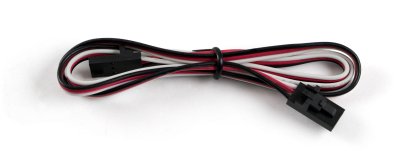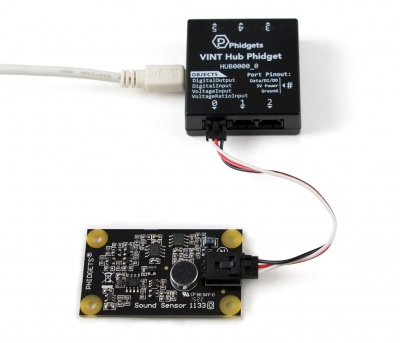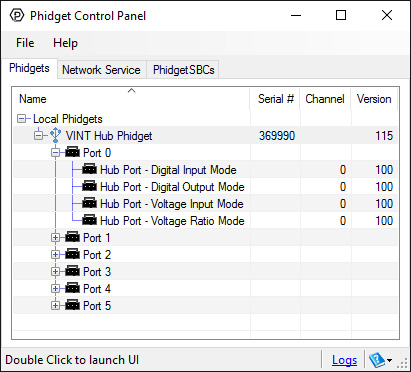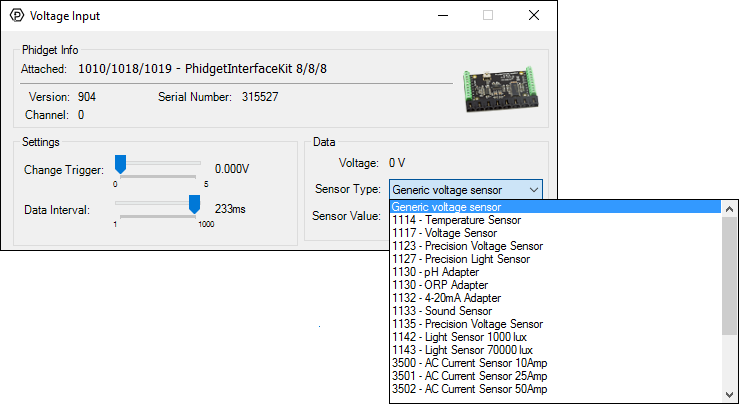Replaced by the SND1000 – Sound Phidget.
The 1133 measures sound pressure level from 50dB to 100dB. This sensor is tuned to measure in the frequency range 100Hz to 8kHz. Outside this range the sensor's bandpass filter will drastically reduce the impact on the measured quantity.

| Board Properties | |
|---|---|
| Controlled By | Voltage Input (0-5V) |
| Sensor Properties | |
| Sensor Type | Sound |
| Controlled By | Voltage Input (0-5V) |
| Sensor Output Type | Non-Ratiometric |
| Sound Level Min | 50 dB |
| Sound Level Max | 100 dB |
| Sound Frequency Min | 100 Hz |
| Sound Frequency Max | 8 kHz |
| Sound Resolution | 0.16 dB |
| Sound Error (at 1000 Hz) | ± 3 dB |
| Electrical Properties | |
| Current Consumption Max | 8.5 mA |
| Output Impedance | 1 kΩ |
| Customs Information | |
| Canadian HS Export Code | 8473.30.00 |
| American HTS Import Code | 8473.30.51.00 |
| Country of Origin | CN (China) |
| Date | Board Revision | Device Version | Comment |
|---|---|---|---|
| March 2010 | 0 | N/A | Product Release |
Welcome to the 1133 user guide! In order to get started, make sure you have the following hardware on hand:
Next, you will need to connect the pieces:

Now that you have everything together, let's start using the 1133!
In order to demonstrate the functionality of the 1133, we will connect it to the HUB0000, and then run an example using the Phidget Control Panel on a Windows machine.
The Phidget Control Panel is available for use on both macOS and Windows machines. If you would like to follow along, first take a look at the getting started guide for your operating system:
Linux users can follow the getting started with Linux guide and continue reading here for more information about the 1133.
After plugging in the 1133 into the HUB0000, and the HUB0000 into your computer, open the Phidget Control Panel. You will see something like this:

The Phidget Control Panel will list all connected Phidgets and associated objects, as well as the following information:
The Phidget Control Panel can also be used to test your device. Double-clicking on an object will open an example.
Double-click on a Voltage Input object in order to run the example:

General information about the selected object will be displayed at the top of the window. You can also experiment with the following functionality:
Sound pressure level (SPL) is measured in dB. The 1133 measures sound across a very wide range, with a frequency range of 100Hz to 8kHz and pressure level from 50dB to 100dB. The formula reports SPL , but the sensor is not sophisticated enough to be used as a substitute for a professional SPL Meter.
The Phidget libraries can automatically convert sensor voltage into sound pressure level (dB) by selecting the appropriate SensorType. See the Phidget22 API for more details. The Formula to translate voltage from the sensor into a sound pressure level is:
Where SPL is the sound pressure level due to a 1kHz tone in decibels.
It is important to note that measuring SPL is very complex and depends on factors other than only the perceived volume. One of the major contributing factors is the frequency of the sound source. Different frequencies of a sine wave with identical amplitudes will generate very different sound pressure levels. Other factors can be the distance between the sound source and the microphone, and even the type of sound source, such as speakers. The bandpass filter of any speaker can affect the output gain at certain frequencies without any change in the volume knob of the speaker. Electrical noise in the power supplied to the sensor can affect the output. If the power supply is very noisy, this will introduce an offset in the output. It is much more noticeable when trying to measure smaller sound pressure levels due to the very small voltages of the microphone being affected much more. As a result, the previous formula is only accurate for a 1kHz pure tone. At other frequencies, there can be up to an 8dB difference between the calculated SPL and the output of a calibrated Sound Pressure Level meter.
The following graph is the response of the 1133 to a 1kHz beep. The beep lasts 75ms. The 1133 has a response time of 1.40ms when placed 30 cm (11.9 inches) from the sound source. The output from the 1133 reduces to normal over the next 80ms.

The voltage output of the sensor can vary by up to 0.1V in a pressure-stable environment. This is especially noticeable at lower output voltages. The best way to deal with this is to average a handful of reported values.

The Phidget Cable is a 3-pin, 0.100 inch pitch locking connector. Pictured here is a plug with the connections labelled. The connectors are commonly available - refer to the Analog Input Primer for manufacturer part numbers.
This sensor can be read by any Phidget with an Analog Input or VINT Hub port. It will connect to either one using the included Phidget cable. VINT Hub ports can behave just like Analog Inputs, but have the added flexibility of being able to be used as digital inputs, digital outputs, or ports to communicate with VINT devices. For more information about VINT, see the VINT Overview page.
| Product | Voltage Inputs | ||
|---|---|---|---|
| Part Number | Price | Number of Voltage Inputs | Voltage Input Resolution (bits) |
 VINT Hub Phidget
|
$40.00 | 6 (Shared) | *** 15 bit |
 1-Port VINT Hub Phidget
|
$24.00 | 1 (Shared) | ** 16 bit |
 VINT Hub Phidget
|
$35.00 | 6 (Shared) | * 15 bit |
 VINT Hub Phidget
|
$30.00 | 6 (Shared) | *** 15 bit |
 Wireless VINT Hub
|
$60.00 | 6 (Shared) | * 16 bit |
 PhidgetSBC4
|
$120.00 | 6 (Shared) | * 16 bit |
 8x Voltage Input Phidget
|
$20.00 | 8 | 12 bit |
 PhidgetInterfaceKit 8/8/8
|
$80.00 | 8 | — |
 PhidgetInterfaceKit 2/2/2
|
$50.00 | 2 | 10 bit |
 PhidgetInterfaceKit 8/8/8
|
$80.00 | 8 | 10 bit |
 PhidgetInterfaceKit 8/8/8 Mini-Format
|
$70.00 | 8 | 10 bit |
 PhidgetInterfaceKit 8/8/8 w/6 Port Hub
|
$110.00 | 8 | 10 bit |
 PhidgetTextLCD 20X2 : White : Integrated PhidgetInterfaceKit 8/8/8
|
$70.00 | 8 | 10 bit |
This sensor comes with its own Phidget cable to connect it to an InterfaceKit or Hub, but if you need extras we have a full list down below. You can solder multiple cables together in order to make even longer Phidget cables, but you should be aware of the effects of having long wires in your system.
| Product | Physical Properties | |
|---|---|---|
| Part Number | Price | Cable Length |
 Phidget Cable 10cm
|
$1.50 | 100 mm |
 Phidget Cable 30cm
|
$1.75 | 300 mm |
 Phidget Cable 60cm
|
$2.00 | 600 mm |
 Phidget Cable 90cm
|
$2.00 | 900 mm |
 Phidget Cable 120cm
|
$2.25 | 1.2 m |
 Phidget Cable 150cm
|
$2.50 | 1.5 m |
 Phidget Cable 180cm
|
$2.75 | 1.8 m |
 Phidget Cable 350cm
|
$3.00 | 3.5 m |
 Phidget Cable Kit
|
$10.00 | 80 mm |
| Product | Board Properties | Sensor Properties | ||
|---|---|---|---|---|
| Part Number | Price | Controlled By | Sound Level Min | Sound Level Max |
 Sound Phidget
|
$15.00 | VINT | * 34 dB | 102 dB |